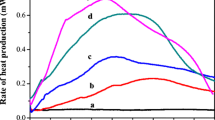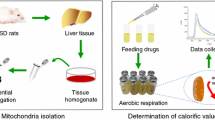Abstract
Effects of methyltriclosan, a biodegradation product of the antimicrobial agent triclosan, on the functional parameters of rat liver mitochondria were studied. It was found that methyltriclosan inhibits the activity of complexes II and IV of the respiratory chain. This causes a decrease in the rate of oxygen consumption by mitochondria in states 3 and 3UDNP. Methyltriclosan was shown to increase the rate of hydrogen peroxide production by rat liver mitochondria. In addition, methyltriclosan induces permeabilization of both mitochondrial membranes and the liposome membranes. Methyltriclosan, in contrast to triclosan, has a milder effect on organelles and their membranes. Possible mechanisms of methyltriclosan effects on mitochondria and liposomes are discussed.






Similar content being viewed by others
REFERENCES
Weatherly L.M., Grosse J.A. 2017. Triclosan exposure, transformation, and human health effects. J. Toxicol. Environ. Health B. Crit. Rev. 20 (8), 447–469.
Levy C.W., Roujeinikova A., Sedelnikova S., Baker P.J., Stuitje A.R., Slabas A.R., Rice D.W, Rafferty J.B. 1999. Molecular basis of triclosan activity. Nature. 398, 383–384.
Heath R.J., Rubin J.R., Holland D.R., Zhang E., Snow M.E., Rock C.O. 1999. Mechanism of triclosan inhibition of bacterial fatty acid synthesis. J. Biol. Chem. 274, 11110–11114.
Zhang L., Niu J., Wang Y. 2016. Full life-cycle toxicity assessment on triclosan using rotifer Brachionus calyciflorus. Ecotoxicol. Environ. Saf. 127, 30–35.
Wang F., Xu R., Zheng F. 2018. Effects of triclosan on acute toxicity, genetic toxicity and oxidative stress in goldfish. Exp. Anim. 67 (2), 219–227.
Palenske N.M., Nallani G.C., Dzialowski E.M. 2010. Physiological effects and bioconcentration of triclosan on amphibian larvae. J. CBPC. 152 (2), 232–240.
Matozzo V.A., Devoti C., Marin M.G. 2012. Immunotoxic effects of triclosan in the clam Ruditapes philippinarum. Ecotoxicology. 21 (1), 66–74.
Feng Y., Zhang P., Zhang Z., Shi J., Jiao Z., Shao B. 2016. Endocrine disrupting effects of triclosan on the placenta in pregnant rats. J. PLoS One. 11 (5), e0154758.
Louis G.W., Hallinger D.R., Braxton M.J., Kamel A., Stoker T.E. 2017. Effects of chronic exposure to triclosan on reproductive and thyroid endpoints in the adult Wistar female rat. Toxicol. Environ. Health A. 80 (4), 236–249.
Paul K.B., Hedge J.M., Bansal R., Zoeller R.T., Peter R., DeVito M.J., Crofton K.M. 2012. Developmental triclosan exposure decreases maternal, fetal, and early neonatal thyroxine: A dynamic and kinetic evaluation of a putative mode-of-action. J. Toxicol. 300 (1–2), 31–45.
Zorrilla L.M., Gibson E.K., Jeffay S.C., Crofton K.M., Setzer W.R., Cooper R.L., Stoker T.E. 2009. The effects of triclosan on puberty and thyroid hormones in male Wistar rats. Toxicol. Sci. 107 (1), 56–64.
Axelstad M., Boberg J., Vinggaard A.M., Christiansen S., Hass U. 2013. Triclosan exposure reduces thyroxine levels in pregnant and lactating rat dams and in directly exposed offspring. J. Food Chem. Toxicol. 59, 534–540.
Wang. X., Chen X., Feng X., Chang F., Chen M., Xia Y., Chen L. 2015. Triclosan causes spontaneous abortion accompanied by decline of estrogen sulfotransferase activity in humans and mice. J. Sci. Rep. 5, 18252.
Teplova V.V., Belosludtsev K.N., Kruglov A.G. 2017. Mechanism of triclosan toxicity: Mitochondrial dysfunction including complex II inhibition, superoxide release and uncoupling of oxidative phosphorylation. Toxicol. Lett. 275, 108–117.
Dubinin M.V., Tenkov K.S., Svinin A.O., Samartsev V.N., Belosludtsev K.N. 2020. Effect of triclosan on the functioning of liver mitochondria and permeability of erythrocyte membranes of marsh frog (Pelophylax ridibundus (Pallas, 1771)). J. Membr. Biol. 253 (1), 1–10.
Belosludtsev K.N., Belosludtseva N.V., Tenkov K.S., Penkov N.V., Agafonov A.V., Pavlik L.L., Yashin V.A., Samartsev V.N., Dubinin M.V. 2018. Study of the mechanism of permeabilization of lecithin liposomes and rat liver mitochondria by the antimicrobial drug triclosan. Biochim. Biophys. Acta Biomembr. 1860 (2), 264–271.
Lindstrom A., Buerge I.J., Poiger T., Bergqvist P.A., Muller M.D., Buser H.R. 2002. Occurrence and environmental behavior of the bactericide triclosan and its methyl derivative in surface waters and in wastewater. Environ. Sci. Technol. 36, 2322–2329.
Chen X., Nielsen J. L., Furgal K., Liu Y., Lolas I.B., Bester K. 2011. Biodegradation of triclosan and formation of methyl-triclosan in activated sludge under aerobic conditions. Chemosphere. 84, 452–456.
Clayborn A.B., Toofan S.N., Champlin F.R. 2011. Influence of methylation on the antibacterial properties of triclosan in Pasteurella multocida and Pseudomonas aeruginosa variant strains. J. Hosp. Infect. 77, 129–133.
Fu J., Gong Z., Bae S. 2019. Assessment of the effect of methyl-triclosan and its mixture with triclosan on developing zebrafish (Danio rerio) embryos using mass spectrometry-based metabolomics. J. Hazard Mater. 368, 186–196.
Chevillot F., Guyot M., Desrosiers M., Cadoret N., Veilleux E., Cabana H., Bellenger J.P. 2019. Accumulation and sublethal effects of triclosan and its transformation product methyl-triclosan in the earthworm Eisenia andrei exposed to environmental concentrations in an artificial soil. Environ. Toxicol. Chem. 37 (7), 1940–1948.
Wang L., Mao B., He H., Shang Y., Zhong Y., Yu Z., Yang Y., Li H., An J. 2018. Comparison of hepatotoxicity and mechanisms induced by triclosan (TCS) and methyl-triclosan (MTCS) in human liver hepatocellular HepG2 cells. Toxicol. Res. (Camb). 8 (1), 38–45.
Rosen M. 2004. Surfactants and interfacial phenomena. 3rd ed. Hoboken: John Wiley & Sons, Inc.
Belosludtsev K.N., Belosludtseva N.V., Agafonov A.V., Astashev M.E., Kazakov A.S., Saris N.-E.L., Mironova G.D. 2014. Ca2+-dependent permeabilization of mitochondria and liposomes by palmitic and oleic acids: A comparative study. Biochim. Biophys. Acta. 1838 (10), 2600–2606.
Lowry O.H., Rosebrough N.J., Farr A.L., Randall R.J. 1951. Protein measurement with the Folin phenol reagent. J. Biol. Chem. 193 (1), 265–275.
Dubinin M.V., Svinin A.O., Vedernikov A.A., Starinets V.S., Tenkov K.S., Belosludtsev K.N., Samartsev V.N. 2019. Effect of hypothermia on the functional activity of liver mitochondria of grass snake (Natrix natrix): inhibition of succinate-fueled respiration and K+ transport, ROS-induced activation of mitochondrial permeability transition. J. Bioenerg. Biomembr. 3, 219–229.
Spinazzi M., Casarin A., Pertegato V., Salviati L., Angelini C. 2012. Assessment of mitochondrial respiratory chain enzymatic activities on tissues and cultured cells. Nat. Protoc. 7, 1235–1246.
Dubinin M.V., Semenova A.A., Ilzorkina A.I., Mikheeva I.B., Yashin V.A., Penkov N.V., Vydrina V.A., Ishmuratov G.Y., Sharapov V.A., Khoroshavina E.I., Gudkov S.V., Belosludtsev K.N. 2020. Effect of betulin and betulonic acid on isolated rat liver mitochondria and liposomes. Biochim. Biophys. Acta. Biomembr. 1862 (10), 183383. https://doi.org/10.1016/j.bbamem.2020.183383
Agafonov A., Gritsenko E., Belosludtsev K., Kovalev A., Gateau-Roesch O., Saris N.-E.L., Mironova G.D. 2003. A permeability transition in liposomes induced by the formation of Ca2+/palmitic acid complexes. Biochim. Biophys. Acta. 1609, 153–160.
ACKNOWLEDGMENTS
The work was supported by grant from the Russian Foundation for Basic Research (20-015-00124) and by the grant of the President of the Russian Federation (MK-61.2019.4).
Author information
Authors and Affiliations
Corresponding author
Ethics declarations
The authors declare that they have no conflict of interest.
All procedures were performed in accordance with the European Communities Council Directive (November 24, 1986; 86/609/EEC) and the Declaration on humane treatment of animals. The Protocol of experiments was approved by the Commission on Bioethics of the Mari State University.
Additional information
Translated by M. Dubinin
Rights and permissions
About this article
Cite this article
Tenkov, K.S., Dubinin, M.V., Semenova, A.A. et al. Effect of Methyltriclosan on the Functioning of Isolated Rat Liver Mitochondria and Permeability of Liposomal Membranes. Biochem. Moscow Suppl. Ser. A 15, 147–155 (2021). https://doi.org/10.1134/S1990747821020082
Received:
Revised:
Accepted:
Published:
Issue Date:
DOI: https://doi.org/10.1134/S1990747821020082




